-
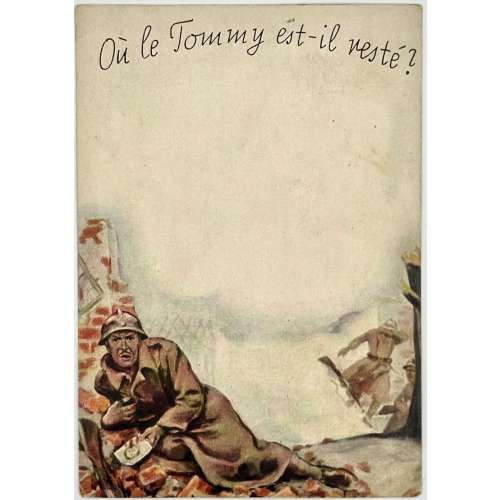 One of a series of six anti-allies propaganda cards, printed in colour, inscribed Ou le Tommy est-il resté? (Where did Tommy stay?), where Tommy is slang for a common soldier in the British Army. The postcards visibly depict French soldiers who fight and die at the western front, while the covert watermark image shows a British military having fun in a bordello. Those cards were printed in the Third Reich for France and dropped from aeroplanes to motivate French soldiers to fight against the British. Size: 149 x 104 mm
One of a series of six anti-allies propaganda cards, printed in colour, inscribed Ou le Tommy est-il resté? (Where did Tommy stay?), where Tommy is slang for a common soldier in the British Army. The postcards visibly depict French soldiers who fight and die at the western front, while the covert watermark image shows a British military having fun in a bordello. Those cards were printed in the Third Reich for France and dropped from aeroplanes to motivate French soldiers to fight against the British. Size: 149 x 104 mm -
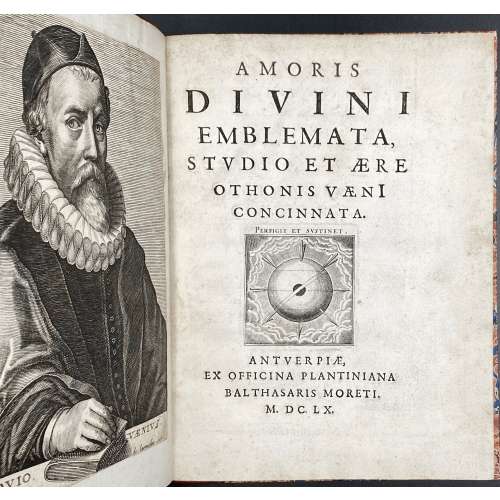 Amoris Divini Emblemata, Studio Et Aere Othonis Vaeni Concinata. — Antverpiae: Ex Officina Plantiniana Balthasaris Moreti, MDCLX [1660]. — pp.: [1] (Van Veen port.), [1] title, [2] (Isabella port.), 3-127 [1], 60 illustr. — 2nd impression. Octavius Vaenius, a.k.a. Otto Vaenius or Otto Van Veen (c. 1556-1629) was Rubens's last and most influential teacher. The Amoris divini emblemata was first published in 1615 by Nutius & Meursius in Antwerp. Vaenius’s book was to influence Herman Hugo's Pia desideria (LIB-1657.2018). Book structure: On frontispiece, trimmed and mounted portrait of Octavius Vaenius painted by his daughter Gertruida van Veen (signed Gertrudis filia) and engraved by Nicolas de Larmessin. Trimmed portrait of the Infanta Isabella Clara of Austria (1566 – 1633) pained by Peter Paul Rubens and engraved by Jan de Leeuw mounted to title verso. 60 engraved plates with emblems are on recto pages with facing texts: Latin quotations from Bible and Fathers, Spanish verses by Alphonso de Ledesma, Dutch by Vaenius and French by Carolus Philippus Hattron (d. 1632). Rebound in the mid-19th century in brown quarter Morocco with blind marbled boards and gilt lettering to spine. Inscription in ink on verso to van Veen portrait: "I bought this volume with the portraits inserted at the sale of the library of my uncle Samuel Rogers, Esq." Signed: "Frederick Sharpe, 1856". Frederick Sharpe (born was a son of Samuel Sharpe (1799–1881), the nephew of Samuel Rogers (1763–1855), a celebrated English poet. Size: 23.3 x 17.9 cm. Ref.: Emblem Project Utrecht (with an explanation of all the emblems); PETER BOOTHUYGENS: Similar or Dissimilar Loves?
Amoris Divini Emblemata, Studio Et Aere Othonis Vaeni Concinata. — Antverpiae: Ex Officina Plantiniana Balthasaris Moreti, MDCLX [1660]. — pp.: [1] (Van Veen port.), [1] title, [2] (Isabella port.), 3-127 [1], 60 illustr. — 2nd impression. Octavius Vaenius, a.k.a. Otto Vaenius or Otto Van Veen (c. 1556-1629) was Rubens's last and most influential teacher. The Amoris divini emblemata was first published in 1615 by Nutius & Meursius in Antwerp. Vaenius’s book was to influence Herman Hugo's Pia desideria (LIB-1657.2018). Book structure: On frontispiece, trimmed and mounted portrait of Octavius Vaenius painted by his daughter Gertruida van Veen (signed Gertrudis filia) and engraved by Nicolas de Larmessin. Trimmed portrait of the Infanta Isabella Clara of Austria (1566 – 1633) pained by Peter Paul Rubens and engraved by Jan de Leeuw mounted to title verso. 60 engraved plates with emblems are on recto pages with facing texts: Latin quotations from Bible and Fathers, Spanish verses by Alphonso de Ledesma, Dutch by Vaenius and French by Carolus Philippus Hattron (d. 1632). Rebound in the mid-19th century in brown quarter Morocco with blind marbled boards and gilt lettering to spine. Inscription in ink on verso to van Veen portrait: "I bought this volume with the portraits inserted at the sale of the library of my uncle Samuel Rogers, Esq." Signed: "Frederick Sharpe, 1856". Frederick Sharpe (born was a son of Samuel Sharpe (1799–1881), the nephew of Samuel Rogers (1763–1855), a celebrated English poet. Size: 23.3 x 17.9 cm. Ref.: Emblem Project Utrecht (with an explanation of all the emblems); PETER BOOTHUYGENS: Similar or Dissimilar Loves? -
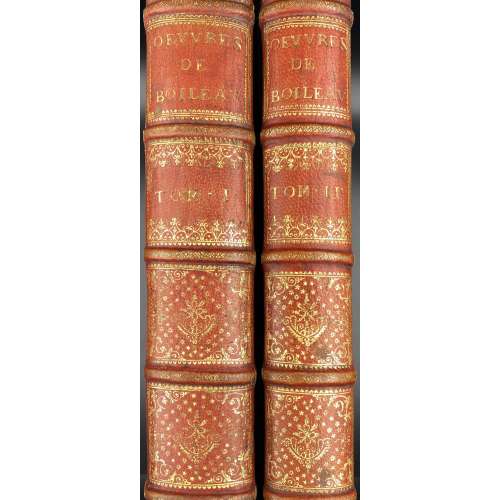 Description: two volumes, 38.3 x 25.5 cm each, uniformly bound in red morocco, boards decorated in gilt in the style of Luc-Antoine Boyet, with gilt dentelle inside out; spine with raised bands, gilt lettering, gilt in compartments; all edges gilt; marbled endpapers; printed on laid paper, text in the floral frame, engraved frontispiece (after Hyacinthe Rigaud), plates, t.p. vignette with the portrait of Desiderius Erasmus (after Quentin Metsys), head- and tailpieces (total of 40, some repeating) and 2 initials by Bernard Picart, folded portrait of dedicatee Guillelmine Charlotte Princesse de Galles &c &c &c by van Gunst after Kneller. Title-page (red and black, tall ‘s’): OEUVRES | DE | NICOLAS BOILEAU | DESPRÉAUX. | AVEC DES | ÉCLAIRCISSEMENTS | HISTORIQUES, | DONNEZ PAR LUI-MEME. | Nouvelle Edition revuë, corrigée & augmentée de diverses Remarques. | Enrichie de figures gravées par Bernard Picart le Romain. | TOME PREMIER (SECOND). | {vignette} | A AMSTERDAM, | Chez DAVID MORTIER. | — | M DCCXVIII. | AVEC PRIVILEGE. || Vol. 1. Collation: 4to; 1 ffl, a-c4 d1 A-3K4, 3L2, 1ffl; (K3 marked I3). Plates: t.p. vignette, frontispiece, 24 head- and tailpieces, f.t. in a grotesque frame and 6 full-page for ‘Le Lutrin’ in the same frame by Bernard Picart; folded portrait of Guillelmine Charlotte, Princess of Wales by van Gunst after Kneller. Pagination: [4] [i-v] vi-xviii [4] [1] 2-450 [2]. Vol. 2. Collation: 4to; 2 ffl, π2 A-3C4 3D3 2 ffl; (V3 marked T3, 2L4 marked A). Plates: t.p. vignette (same as vol.1) and 7 head- and tailpieces by Bernard Picart. Pagination: [4] [i-iii] iv-vii [viii] [1] 2-370 [2] [20]. Catalogue raisonné: Lewine 72-3; Cohen-De Ricci 165-6. Contributors: Luc-Antoine Boyet (French, fl. 1684 – 1733) – bookbinder. Claude Brossette (French, 1671 – 1743) – author, remarks. André Dacier (French, 1651 – 1722) – author, preface. Nicolas Boileau Despréaux (French, 1636 – 1711) – author. Pieter Stevens van Gunst (Dutch, 1659-1724) – engraver. Sir Godfrey Kneller (British, 1646-1723) – artist. David Mortier (Dutch-British, 1673 – 1728) – publisher. Bernard Picard (French, 1673 – 1733) – artist, engraver. Quentin Massijs [Metsys, Matsys] (Flemish, 1466 – 1530) – artist. Hyacinthe Rigaud [Jacint Rigau-Ros i Serra] (French, 1659 - 1743) – artist. Guillelmine Charlotte, Princess of Wales (Wilhelmina Charlotte Caroline of Brandenburg-Ansbach) (1683 – 1737) – dedicatee
Description: two volumes, 38.3 x 25.5 cm each, uniformly bound in red morocco, boards decorated in gilt in the style of Luc-Antoine Boyet, with gilt dentelle inside out; spine with raised bands, gilt lettering, gilt in compartments; all edges gilt; marbled endpapers; printed on laid paper, text in the floral frame, engraved frontispiece (after Hyacinthe Rigaud), plates, t.p. vignette with the portrait of Desiderius Erasmus (after Quentin Metsys), head- and tailpieces (total of 40, some repeating) and 2 initials by Bernard Picart, folded portrait of dedicatee Guillelmine Charlotte Princesse de Galles &c &c &c by van Gunst after Kneller. Title-page (red and black, tall ‘s’): OEUVRES | DE | NICOLAS BOILEAU | DESPRÉAUX. | AVEC DES | ÉCLAIRCISSEMENTS | HISTORIQUES, | DONNEZ PAR LUI-MEME. | Nouvelle Edition revuë, corrigée & augmentée de diverses Remarques. | Enrichie de figures gravées par Bernard Picart le Romain. | TOME PREMIER (SECOND). | {vignette} | A AMSTERDAM, | Chez DAVID MORTIER. | — | M DCCXVIII. | AVEC PRIVILEGE. || Vol. 1. Collation: 4to; 1 ffl, a-c4 d1 A-3K4, 3L2, 1ffl; (K3 marked I3). Plates: t.p. vignette, frontispiece, 24 head- and tailpieces, f.t. in a grotesque frame and 6 full-page for ‘Le Lutrin’ in the same frame by Bernard Picart; folded portrait of Guillelmine Charlotte, Princess of Wales by van Gunst after Kneller. Pagination: [4] [i-v] vi-xviii [4] [1] 2-450 [2]. Vol. 2. Collation: 4to; 2 ffl, π2 A-3C4 3D3 2 ffl; (V3 marked T3, 2L4 marked A). Plates: t.p. vignette (same as vol.1) and 7 head- and tailpieces by Bernard Picart. Pagination: [4] [i-iii] iv-vii [viii] [1] 2-370 [2] [20]. Catalogue raisonné: Lewine 72-3; Cohen-De Ricci 165-6. Contributors: Luc-Antoine Boyet (French, fl. 1684 – 1733) – bookbinder. Claude Brossette (French, 1671 – 1743) – author, remarks. André Dacier (French, 1651 – 1722) – author, preface. Nicolas Boileau Despréaux (French, 1636 – 1711) – author. Pieter Stevens van Gunst (Dutch, 1659-1724) – engraver. Sir Godfrey Kneller (British, 1646-1723) – artist. David Mortier (Dutch-British, 1673 – 1728) – publisher. Bernard Picard (French, 1673 – 1733) – artist, engraver. Quentin Massijs [Metsys, Matsys] (Flemish, 1466 – 1530) – artist. Hyacinthe Rigaud [Jacint Rigau-Ros i Serra] (French, 1659 - 1743) – artist. Guillelmine Charlotte, Princess of Wales (Wilhelmina Charlotte Caroline of Brandenburg-Ansbach) (1683 – 1737) – dedicatee -
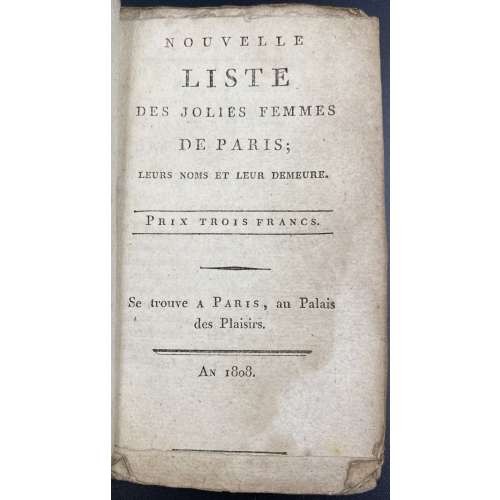 Title: NOUVELLE | LISTE | DES JOLIES FEMMES | DE PARIS ; | LEURS NOMS ET LEUR DEMEURE. | PRIX TROIS FRANCS. | Se trouve A Paris , au Palais des plaisirs. | — | An 1808. || Pagination : [1-6] 7-70 [2 blank] Collation : 9vo, [A]9 B-D9. Binding: Original blue wrappers, 15 x 9 cm. Ref: OCLC finds only one copy, at the British Library. The BnF has a work of the same title, with the same pagination, dated 1803. The stated publisher seems to be fictitious. Quaritch description: 12mo, pp. 70; a little dusty, a few spots and marks; a very good uncut copy in original blue/grey wrappers; somewhat worn and stained. Very rare guide to Parisian prostitutes providing an extraordinary snapshot of the state of prostitution in the city during the First French Empire. The anonymous compiler begins with a brief history of prostitution in the capital, and its regulation, under Charlemagne and Louis VIII, describes a brothel established by Joanna I of Naples at Avignon and discusses Pierre-Jean Grosley’s estimate of the number of prostitutes in London. He then provides his liste, divided into categories including ‘houses of the first order’, ‘bawdy houses’, ‘actresses’, ‘washerwomen’, and ‘procuresses’, giving the name of each prostitute, an indication of their age, and their physical attributes, character, and particular talents. Rosanne, for example, chez Madame l’Évêque at the Palais du Tribunat, offers ‘unspeakably voluptuous pleasures to the nether regions’; Honorine prefers women; Scholastique likes wine with her lovemaking; Nanette has a penchant for soldiers; Genevieve favours the priapic; Dorsay enjoys S&M, and Madame Laperriere promises rejuvenation to the elderly. One Ducroisy is poetically described as possessing ‘a tuft as black as a crow above two alabaster columns’, while Félicité has skin ‘soft and white, sprinkled with golden freckles, like gold in Maraschino liqueur’. The author hopes that his listed will bring business to the ladies and pleasure to their clients, beseeching both to look after their health so that his guide might ‘serve Love, not Asclepius’.
Title: NOUVELLE | LISTE | DES JOLIES FEMMES | DE PARIS ; | LEURS NOMS ET LEUR DEMEURE. | PRIX TROIS FRANCS. | Se trouve A Paris , au Palais des plaisirs. | — | An 1808. || Pagination : [1-6] 7-70 [2 blank] Collation : 9vo, [A]9 B-D9. Binding: Original blue wrappers, 15 x 9 cm. Ref: OCLC finds only one copy, at the British Library. The BnF has a work of the same title, with the same pagination, dated 1803. The stated publisher seems to be fictitious. Quaritch description: 12mo, pp. 70; a little dusty, a few spots and marks; a very good uncut copy in original blue/grey wrappers; somewhat worn and stained. Very rare guide to Parisian prostitutes providing an extraordinary snapshot of the state of prostitution in the city during the First French Empire. The anonymous compiler begins with a brief history of prostitution in the capital, and its regulation, under Charlemagne and Louis VIII, describes a brothel established by Joanna I of Naples at Avignon and discusses Pierre-Jean Grosley’s estimate of the number of prostitutes in London. He then provides his liste, divided into categories including ‘houses of the first order’, ‘bawdy houses’, ‘actresses’, ‘washerwomen’, and ‘procuresses’, giving the name of each prostitute, an indication of their age, and their physical attributes, character, and particular talents. Rosanne, for example, chez Madame l’Évêque at the Palais du Tribunat, offers ‘unspeakably voluptuous pleasures to the nether regions’; Honorine prefers women; Scholastique likes wine with her lovemaking; Nanette has a penchant for soldiers; Genevieve favours the priapic; Dorsay enjoys S&M, and Madame Laperriere promises rejuvenation to the elderly. One Ducroisy is poetically described as possessing ‘a tuft as black as a crow above two alabaster columns’, while Félicité has skin ‘soft and white, sprinkled with golden freckles, like gold in Maraschino liqueur’. The author hopes that his listed will bring business to the ladies and pleasure to their clients, beseeching both to look after their health so that his guide might ‘serve Love, not Asclepius’. -
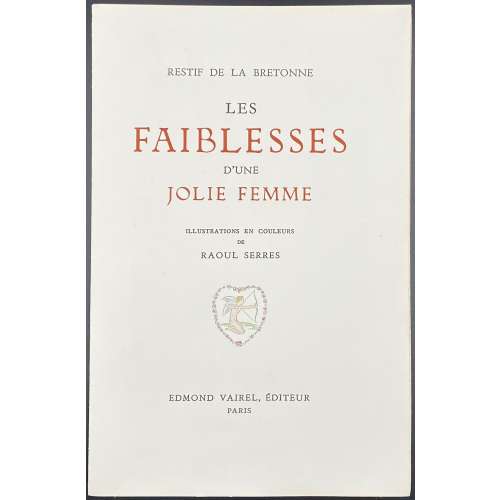 Title-page (red and black): RESTIF DE LA BRETONNE | LES | FAIBLESSES | D'UNE | JOLIE FEMME | ILLUSTRATIONS EN COULEURS | DE | RAOUL SERRES | {VIGNETTE} | EDMOND VAIREL, ÉDITEUR | PARIS || Description: 25.8 x 17 cm, French flapped wrappers lettered in red and black “LES | FAIBLESSES | D'UNE | JOLIE FEMME” in a 26 x 18 cm tan cloth double slipcase, [1-14] 15-175 [176] [8], collated in-8vo, with 25 colour in-text woodcut vignettes and two tailpieces at the end of each chapter, by Gérard Angiolini after watercolours by Raoul Serres. Published: April 18, 1951, in Paris. Edition: 1st thus, limited edition of 1,025 copies, of which this is № 904 of a common print run on Vélin de Rives paper (numbered 101-1,000). Contributors: Nicolas Restif de la Bretonne [Nicolas-Edme Rétif] (French, 1734 – 1806) – author. Raoul Serres [Schem] (French, 1881 – 1971) – artist. Gérard Angiolini (French, fl. 1946 – 1957) – engraver. Imprimerie Coulouma (Argenteuil), Robert Coulouma (French, 1887-1976) – printer. Edmond Vairel (French, 18… – 19...) – publisher, colourist.
Title-page (red and black): RESTIF DE LA BRETONNE | LES | FAIBLESSES | D'UNE | JOLIE FEMME | ILLUSTRATIONS EN COULEURS | DE | RAOUL SERRES | {VIGNETTE} | EDMOND VAIREL, ÉDITEUR | PARIS || Description: 25.8 x 17 cm, French flapped wrappers lettered in red and black “LES | FAIBLESSES | D'UNE | JOLIE FEMME” in a 26 x 18 cm tan cloth double slipcase, [1-14] 15-175 [176] [8], collated in-8vo, with 25 colour in-text woodcut vignettes and two tailpieces at the end of each chapter, by Gérard Angiolini after watercolours by Raoul Serres. Published: April 18, 1951, in Paris. Edition: 1st thus, limited edition of 1,025 copies, of which this is № 904 of a common print run on Vélin de Rives paper (numbered 101-1,000). Contributors: Nicolas Restif de la Bretonne [Nicolas-Edme Rétif] (French, 1734 – 1806) – author. Raoul Serres [Schem] (French, 1881 – 1971) – artist. Gérard Angiolini (French, fl. 1946 – 1957) – engraver. Imprimerie Coulouma (Argenteuil), Robert Coulouma (French, 1887-1976) – printer. Edmond Vairel (French, 18… – 19...) – publisher, colourist. -
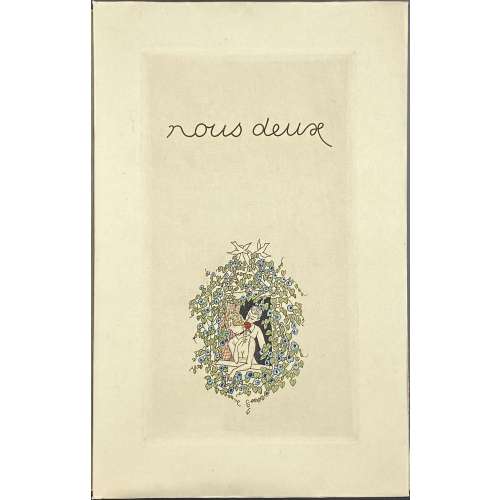 Description: Two volumes 23.1 x 14.9 cm each, collated in 4to, uniformly bound in French flapped wrappers with the title and an engraved vignette, coloured; wrapped in glassine; cased in a cardboard chemise (23.1 x 15 cm) with a diaper of two hearts pierced by an arrow, in pink; and both volumes cased in a slipcase (23.8 x 15.2 cm) with the same diaper. Printed on unpaginated dense wove paper watermarked ‘Arches’, engravings with clear plate marks. Illustrations are by Jean Dulac. Title-page (double-fillet frame, black and red in manuscript) Nelly et Jean | – | nous deux | simples | papiers | du| tiroir secret | {vignette} | Première partie (Deuxième partie) | – | Gravé | et imprimé | pour les auteurs | et leurs amis || Vol. 1: 1 blank, π4 (blank, h.t., frontis., engr. t.p.), 1-84, [2 blanks]; total 39 leaves with 19 hand-coloured burin engravings, incl. wrapper, frontis., and t.p. Unpag. Vol. 2: 1 blank, π4 (blank, h.t., frontis., engr. t.p.), 1-114, [1 colophon] [2 blanks], total 52 leaves with 27 hand-coloured burin engravings, incl. wrapper, frontis., and t.p. Unpag. Limitation: total print run of 295 copies of which 12 (№№ 1-12) on Japon Impérial, 13 on Vélin d’Arches (№№ 13-25), 30 on Japon Impérial (№№ 26-55) and 240 on Vélin d’Arches (№№ 56-295); this is copy № 97 on Vélin d’Arches. Contributors: Marcel Valotaire (French, 1889 – 1979) – author. Jean Dulac (French, 1902 – 1968) – artist. Printed by Coulouma (Argenteuil) and Vernant (Paris). The same title with illustrations by Gaston de Sainte-Croix was published in 1956: LIB-2880.2021.
Description: Two volumes 23.1 x 14.9 cm each, collated in 4to, uniformly bound in French flapped wrappers with the title and an engraved vignette, coloured; wrapped in glassine; cased in a cardboard chemise (23.1 x 15 cm) with a diaper of two hearts pierced by an arrow, in pink; and both volumes cased in a slipcase (23.8 x 15.2 cm) with the same diaper. Printed on unpaginated dense wove paper watermarked ‘Arches’, engravings with clear plate marks. Illustrations are by Jean Dulac. Title-page (double-fillet frame, black and red in manuscript) Nelly et Jean | – | nous deux | simples | papiers | du| tiroir secret | {vignette} | Première partie (Deuxième partie) | – | Gravé | et imprimé | pour les auteurs | et leurs amis || Vol. 1: 1 blank, π4 (blank, h.t., frontis., engr. t.p.), 1-84, [2 blanks]; total 39 leaves with 19 hand-coloured burin engravings, incl. wrapper, frontis., and t.p. Unpag. Vol. 2: 1 blank, π4 (blank, h.t., frontis., engr. t.p.), 1-114, [1 colophon] [2 blanks], total 52 leaves with 27 hand-coloured burin engravings, incl. wrapper, frontis., and t.p. Unpag. Limitation: total print run of 295 copies of which 12 (№№ 1-12) on Japon Impérial, 13 on Vélin d’Arches (№№ 13-25), 30 on Japon Impérial (№№ 26-55) and 240 on Vélin d’Arches (№№ 56-295); this is copy № 97 on Vélin d’Arches. Contributors: Marcel Valotaire (French, 1889 – 1979) – author. Jean Dulac (French, 1902 – 1968) – artist. Printed by Coulouma (Argenteuil) and Vernant (Paris). The same title with illustrations by Gaston de Sainte-Croix was published in 1956: LIB-2880.2021. -
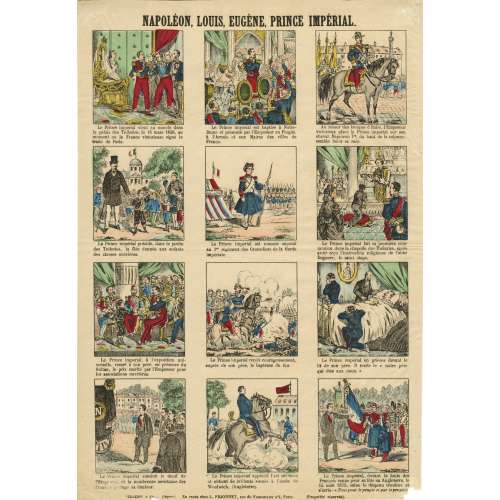 Hand-coloured woodcut on wove paper, 400 x 277 mm. Top: "NAPOLÉON, LOUIS, EUGÈNE, PRINCE IMPÉRIAL"; bellow 12 captioned frames:
Hand-coloured woodcut on wove paper, 400 x 277 mm. Top: "NAPOLÉON, LOUIS, EUGÈNE, PRINCE IMPÉRIAL"; bellow 12 captioned frames:- Le Prince impérial vient au monde dans le palais des Tuileries, le 16 mars 1856, au moment où la France victorieuse signe le traité de Paris.
- Le Prince impérial est baptisé à Notre-Dame et présenté par l'Empereur au Peuple, à l’Armée et aux Maires des villes de France.
- Au retour des troupes d'Italie, l'Empereur victorieux place le Prince impérial sur son cheval. Napoléon Ier, du haut de la colonne, semble bénir sa race.
- Le Prince impérial préside, dans le jardin des Tuileries, la fête donnée aux enfants des classes ouvrières.
- Le Prince impérial est nommé caporal au 1er régiment des Grenadiers de la Garde impériale.
- Le Prince impérial fait sa première communion dans la chapelle des Tuileries, après avoir reçu l'instruction religieuse de l'abbé Deguerry, le saint otage.
- Le Prince impérial, à l'exposition universelle, remet à son père. en présence du Sultan, le prix mérité par l'Empereur pour les associations ouvrières.
- Le Prince impérial reçoit courageusement, auprès de son père, le baptême du feu.
- Le Prince impérial en prières devant le lit de son père. Il récite le « notre père qui ètes aux cieux. »
- Le Prince impérial conduit le deuil de l'Empereur, et la nombreuse assistance des Français portage sa douleur.
- Le Prince impérial apprend l’art militaire et obtient de brillants succès à l'écolo de Woolwich, (Angleterre).
- Le Prince impérial, devant la foule des Français venus pour sa fête en Angleterre, le 15 out 1873, salue le drapeau tricolore et s'écrie : « Tout pour le peuple et par le peuple… »
-
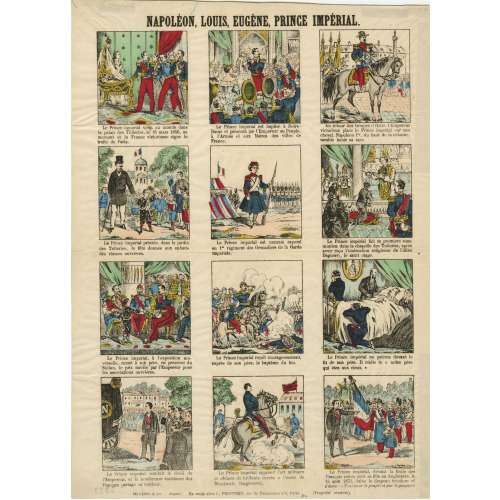 Another copy of SVFC-0745-3.2023, 395 x 290 mm; black ink stamp “5322” to reverse. Jean Charles Pellerin (French, 1756 – 1836)
Another copy of SVFC-0745-3.2023, 395 x 290 mm; black ink stamp “5322” to reverse. Jean Charles Pellerin (French, 1756 – 1836) -
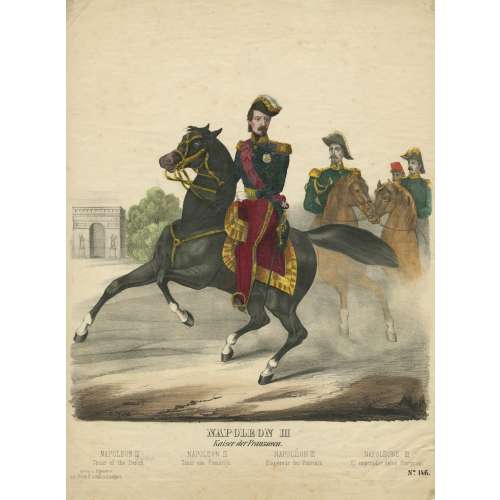 Hand-coloured lithography on wove paper 423 x 332 mm; On reverse: black ink stamp “4956”, ms “A”, ms pencil “428” and “Ernest”. Under the image, centre: "NAPOLEON III | Kaiser der Franzosen." Velow: | NAPOLEON III | Czaar of the French — NAPOLEON III | Czaar van Frankrijk — NAPOLÉON III | Empereur des Francais. — NAPOLEONE III | El emperador delos Franceses; bottom left: "Verlag u. Eigenthum | von. Fried. G. Schulz in Stuttgart.", right: "No 146." The artist's and printer's names in stone are not legible. Published in Stuttgart by Friederich Gustav Schulz (German, 1786 – 1859) during the time of the Second French Empire (1852-1870).
Hand-coloured lithography on wove paper 423 x 332 mm; On reverse: black ink stamp “4956”, ms “A”, ms pencil “428” and “Ernest”. Under the image, centre: "NAPOLEON III | Kaiser der Franzosen." Velow: | NAPOLEON III | Czaar of the French — NAPOLEON III | Czaar van Frankrijk — NAPOLÉON III | Empereur des Francais. — NAPOLEONE III | El emperador delos Franceses; bottom left: "Verlag u. Eigenthum | von. Fried. G. Schulz in Stuttgart.", right: "No 146." The artist's and printer's names in stone are not legible. Published in Stuttgart by Friederich Gustav Schulz (German, 1786 – 1859) during the time of the Second French Empire (1852-1870). -
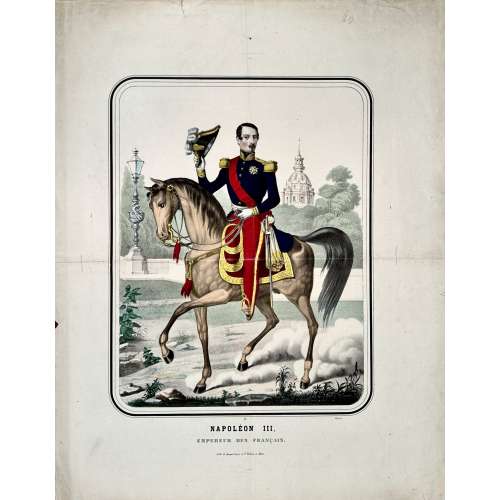 Hand-coloured chromolithography on wove paper, 600 x 470 mm; black ink stamp “4921” to reverse, horizontal and vertical centrefolds. Image of Napoléon III on horseback, in a frame; lettering under the frame: 34 — Déposé | NAPOLÉON III | EMPEREUR DES FRANÇAIS. | Lith. de Gangel frères et P. Didion, à Metz. || Gangel frères et P. Didion (Metz) – printer/publisher. Paulin Didion (French, 1831 – 1879)
Hand-coloured chromolithography on wove paper, 600 x 470 mm; black ink stamp “4921” to reverse, horizontal and vertical centrefolds. Image of Napoléon III on horseback, in a frame; lettering under the frame: 34 — Déposé | NAPOLÉON III | EMPEREUR DES FRANÇAIS. | Lith. de Gangel frères et P. Didion, à Metz. || Gangel frères et P. Didion (Metz) – printer/publisher. Paulin Didion (French, 1831 – 1879) -
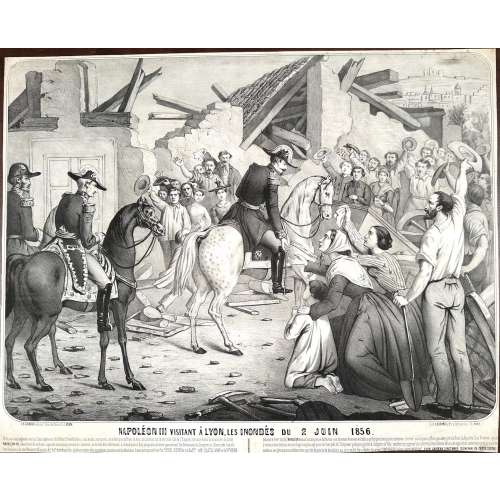 Lithography poster on wove paper, 492 x 614 mm; black ink stamp “5036” to reverse, vertical centerfold. Image in frame; under the frame left: "J. B. Gadola, éditeur. Cours de Brosses 1, à LYON."; right: "Lith LAURANT & Cie r. de Bernardins 34, Paris." Title and text below the image. Jean-Baptiste Gadola (French, 1818 – 1870) – publisher.
Lithography poster on wove paper, 492 x 614 mm; black ink stamp “5036” to reverse, vertical centerfold. Image in frame; under the frame left: "J. B. Gadola, éditeur. Cours de Brosses 1, à LYON."; right: "Lith LAURANT & Cie r. de Bernardins 34, Paris." Title and text below the image. Jean-Baptiste Gadola (French, 1818 – 1870) – publisher. -
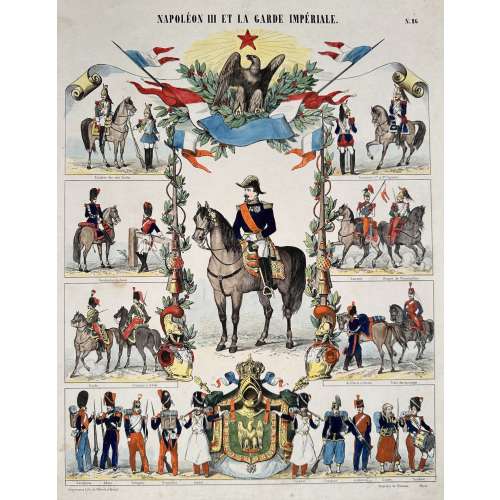 Hand-coloured woodcut on wove paper, 460 x 356 mm; black ink stamp “5055” to reverse. Top centre: "NAPOLÉON III ET LA GARDE IMPÉRIALE"; right: "№ 86". Napoléon III ahorseback in middle, beside (top to bottom): Escadron des cent Gardes — Cuirassiers 1er et 2me regiment; Gendarmes à cheval. — Lancier., Dragon de l’Impératrice.; Guide., Chasseur à cheval. — Artillerie à cheval, Train des équipages.; Gendarme. Génie. Voltigeur. Grenadier. Sapeur. Sapeur. Chasseur. Artillerie. Zouave. Tambour. Bottom left: Imprimerie Lith. de Pellerin à Épinal; right: Propriété de l’Éditeur. Déposé. Jean Charles Pellerin (French, 1756 – 1836) – printer/publisher.
Hand-coloured woodcut on wove paper, 460 x 356 mm; black ink stamp “5055” to reverse. Top centre: "NAPOLÉON III ET LA GARDE IMPÉRIALE"; right: "№ 86". Napoléon III ahorseback in middle, beside (top to bottom): Escadron des cent Gardes — Cuirassiers 1er et 2me regiment; Gendarmes à cheval. — Lancier., Dragon de l’Impératrice.; Guide., Chasseur à cheval. — Artillerie à cheval, Train des équipages.; Gendarme. Génie. Voltigeur. Grenadier. Sapeur. Sapeur. Chasseur. Artillerie. Zouave. Tambour. Bottom left: Imprimerie Lith. de Pellerin à Épinal; right: Propriété de l’Éditeur. Déposé. Jean Charles Pellerin (French, 1756 – 1836) – printer/publisher. -
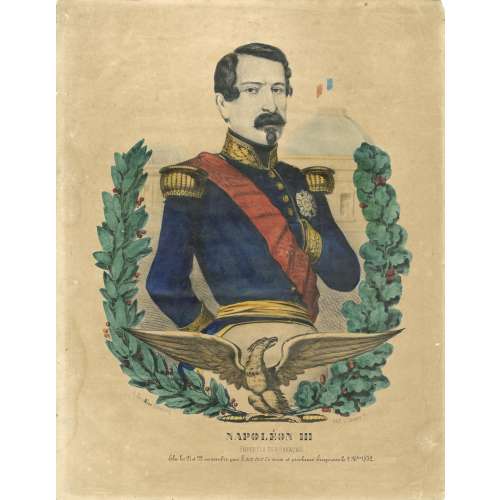 Hand-coloured lithography on wove paper, 380 x 298 mm; black ink stamp “4912” to reverse. On stone left: "A, Paris Miné Éditeur, imp.;" right: "Lith. R. St. Jacques. 41." Bottom center: "Napoléon III"; below: "EMPEREUR DES FRANÇAIS", under: "Élu les 21 el 22 novembre par 8,000,000 de voix et proclamé Empereur le 2 Xbre 1852." Printer/publisher: Miné, éditeur, imprimeur en lithographie, Rue Saint-Jacques, 41. Napoleon III [Charles-Louis Napoléon Bonaparte] (French, 1808 – 1873)
Hand-coloured lithography on wove paper, 380 x 298 mm; black ink stamp “4912” to reverse. On stone left: "A, Paris Miné Éditeur, imp.;" right: "Lith. R. St. Jacques. 41." Bottom center: "Napoléon III"; below: "EMPEREUR DES FRANÇAIS", under: "Élu les 21 el 22 novembre par 8,000,000 de voix et proclamé Empereur le 2 Xbre 1852." Printer/publisher: Miné, éditeur, imprimeur en lithographie, Rue Saint-Jacques, 41. Napoleon III [Charles-Louis Napoléon Bonaparte] (French, 1808 – 1873) -
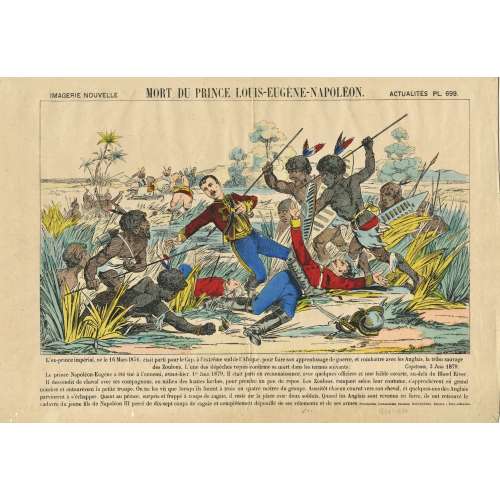 Hand-coloured lithography on wove paper, 275 x 385 mm; vertical centerfold, image in frame. On reverse: black ink stamp “5350”. Above the frame: "IMAGERIE NOUVELLE — MORT DU PRINCE LOUIS-EUGÈNE-NAPOLÉON. — ACTUALITÉS PL. 699". Under the frame: "L'ex-prince impérial, né le 16 Mars I856, était parti pour le Cap, à l'extrême sud de l'Afrique, pour faire son apprentissage de guerre, et combattre avec les Anglais, la tribu sauvage des Zoulous. L'une des dépêches reçues confirme sa mort dans les termes suivants: — Capetown, 3 Juin 1879. — Le prince Napoléon-Eugène a été tué à l'ennemi, avant-hier, 1er Juin 1879, Il était parti en reconnaissance, avec quelques officiers et une fable escorte, au-delà du Blood River. Il descendit de cheval ave ses compagnons, au milieu des hautes herbes, pour prendre un peu de repos. Les Zoulous, rampant selon leur coutume, s'approchèrent en grand nombre et entourèrent la petite troupe. On ne les vit que lorsqu' ils furent à trois ou quatre mètres du groupe. Aussitôt chacun court vers son cheval, et quelques-uns des Anglais parvinrent à s'échapper. Quant au prince, surpris et frappé à coups de zagaie, il resta sur la place avec deux soldats. Quand les Anglais sont revenus en force, ils ont retrouvé le cadavre du jeune fils de Napoléon III percé de dix-sept coups de zagaie et complétement dépouillé de ses vêtements et de ses armes". — "Typographie, Lithographie, Imagerie, Haguenthal, Éditeur à Pont-à-Mousson". Pencil ms: "1860-1880". Élie Haguenthal (French, 1822 – 1881) – publisher/printer.
Hand-coloured lithography on wove paper, 275 x 385 mm; vertical centerfold, image in frame. On reverse: black ink stamp “5350”. Above the frame: "IMAGERIE NOUVELLE — MORT DU PRINCE LOUIS-EUGÈNE-NAPOLÉON. — ACTUALITÉS PL. 699". Under the frame: "L'ex-prince impérial, né le 16 Mars I856, était parti pour le Cap, à l'extrême sud de l'Afrique, pour faire son apprentissage de guerre, et combattre avec les Anglais, la tribu sauvage des Zoulous. L'une des dépêches reçues confirme sa mort dans les termes suivants: — Capetown, 3 Juin 1879. — Le prince Napoléon-Eugène a été tué à l'ennemi, avant-hier, 1er Juin 1879, Il était parti en reconnaissance, avec quelques officiers et une fable escorte, au-delà du Blood River. Il descendit de cheval ave ses compagnons, au milieu des hautes herbes, pour prendre un peu de repos. Les Zoulous, rampant selon leur coutume, s'approchèrent en grand nombre et entourèrent la petite troupe. On ne les vit que lorsqu' ils furent à trois ou quatre mètres du groupe. Aussitôt chacun court vers son cheval, et quelques-uns des Anglais parvinrent à s'échapper. Quant au prince, surpris et frappé à coups de zagaie, il resta sur la place avec deux soldats. Quand les Anglais sont revenus en force, ils ont retrouvé le cadavre du jeune fils de Napoléon III percé de dix-sept coups de zagaie et complétement dépouillé de ses vêtements et de ses armes". — "Typographie, Lithographie, Imagerie, Haguenthal, Éditeur à Pont-à-Mousson". Pencil ms: "1860-1880". Élie Haguenthal (French, 1822 – 1881) – publisher/printer. -
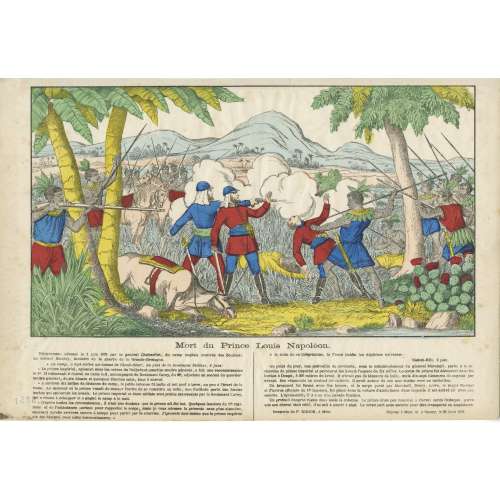 Hand-coloured woodcut on wove paper, 267 x 390 mm. On reverse: black ink stamp “5351”. Centre, under the image frame "Mort du Prince Louis Napoléon". Below left: "Télégramme adressé le 2 juin 1879 par le général Chelmsfort, du camp anglais (contrée des Zoulous), au colonel Stanley, ministre de la guerre de la Grande-Bretagne. « Au camp, à sept milles au-dessus de Blood-River, au pied de la montagne Stellezi, 2 juin: Le prince impérial, agissant sous les ordres de l'adjudant quartier-maitre général. a fait une reconnaissance le 1er. Il retournait à cheval au camp le 2 accompagné du lieutenant Carey, du 98e adjudant en second du quartier-maitre général. de six blancs et, quelques Zoulous amis, tous à cheval. A environ dix milles de distance du camp, la petite colonne fit halte at mit pied à terre, un peu à l’écart de la route. Au moment ou le prince venait de donner l'ordre de se remettre en selle. une fusillade partit des hautes herbes qui entourant les kraals. Le prince impérial et deux soldats sont portés manquants par le lieutenant Carey, qui a réussi à échapper et a gagné le camp à la nuit. D'après toutes les circonstances, il 'est pas douteux quo le prince ait été tué. Quelques lanciers du 17 régiment et de l'ambulance partent pour rapporter le corps; mais je vous adresse la présente sans plus attendre, espérant qu'elle arrivera encore à temps pour partir par le courrier. J’ignorais moi-même que le prince impérial eût été désigné pour cette reconnaissance. »" Below right: A la suite de le télégramme, le Times publie les dépêches suivantes: Stelezi-Hill, 2 juin. Au point du jour, une patrouille de cavalerie, sous le commandement du général Marshall. partit à la recherche du prince impérial et parcourut les kraals l'espace de dix milles. Le corps du prince fut découvert dans les herbes à Donga, à 300 mètres du kraal. Il n'avait pas de blessure de balle, mais dix-sept blessures de zagaies par devant. Ses vêtements lui avaient été enlevés. I avait autour du cou une chaine avec un médaillon. Un brancard fut formé avec les lances, et le corps porté par Marchall, Drury, Lowe, le mjor Stewart et d'autres officiers du 17e lanciers, fut. place dans la voiture d'ambulance dans laquelle il est arrivé ici avec une escorte. L'après-midi, il v a eu une parade funèbre. Un profond chagrin règne dans toute la colonne. Le prince n'est pas remonté à cheval après l’attique, parce que son cheval était rétif ; il se mit à courir à pied. Le corps part sous escorte pour être transporté en Angleterre. Bottom right: "Imagerie de P. DIDION, à Metz — Déposé à Metz et à Nancy, le 25 Juin 1879". Paulin Didion (French, 1831 – 1879) – publisher/printer.
Hand-coloured woodcut on wove paper, 267 x 390 mm. On reverse: black ink stamp “5351”. Centre, under the image frame "Mort du Prince Louis Napoléon". Below left: "Télégramme adressé le 2 juin 1879 par le général Chelmsfort, du camp anglais (contrée des Zoulous), au colonel Stanley, ministre de la guerre de la Grande-Bretagne. « Au camp, à sept milles au-dessus de Blood-River, au pied de la montagne Stellezi, 2 juin: Le prince impérial, agissant sous les ordres de l'adjudant quartier-maitre général. a fait une reconnaissance le 1er. Il retournait à cheval au camp le 2 accompagné du lieutenant Carey, du 98e adjudant en second du quartier-maitre général. de six blancs et, quelques Zoulous amis, tous à cheval. A environ dix milles de distance du camp, la petite colonne fit halte at mit pied à terre, un peu à l’écart de la route. Au moment ou le prince venait de donner l'ordre de se remettre en selle. une fusillade partit des hautes herbes qui entourant les kraals. Le prince impérial et deux soldats sont portés manquants par le lieutenant Carey, qui a réussi à échapper et a gagné le camp à la nuit. D'après toutes les circonstances, il 'est pas douteux quo le prince ait été tué. Quelques lanciers du 17 régiment et de l'ambulance partent pour rapporter le corps; mais je vous adresse la présente sans plus attendre, espérant qu'elle arrivera encore à temps pour partir par le courrier. J’ignorais moi-même que le prince impérial eût été désigné pour cette reconnaissance. »" Below right: A la suite de le télégramme, le Times publie les dépêches suivantes: Stelezi-Hill, 2 juin. Au point du jour, une patrouille de cavalerie, sous le commandement du général Marshall. partit à la recherche du prince impérial et parcourut les kraals l'espace de dix milles. Le corps du prince fut découvert dans les herbes à Donga, à 300 mètres du kraal. Il n'avait pas de blessure de balle, mais dix-sept blessures de zagaies par devant. Ses vêtements lui avaient été enlevés. I avait autour du cou une chaine avec un médaillon. Un brancard fut formé avec les lances, et le corps porté par Marchall, Drury, Lowe, le mjor Stewart et d'autres officiers du 17e lanciers, fut. place dans la voiture d'ambulance dans laquelle il est arrivé ici avec une escorte. L'après-midi, il v a eu une parade funèbre. Un profond chagrin règne dans toute la colonne. Le prince n'est pas remonté à cheval après l’attique, parce que son cheval était rétif ; il se mit à courir à pied. Le corps part sous escorte pour être transporté en Angleterre. Bottom right: "Imagerie de P. DIDION, à Metz — Déposé à Metz et à Nancy, le 25 Juin 1879". Paulin Didion (French, 1831 – 1879) – publisher/printer. -
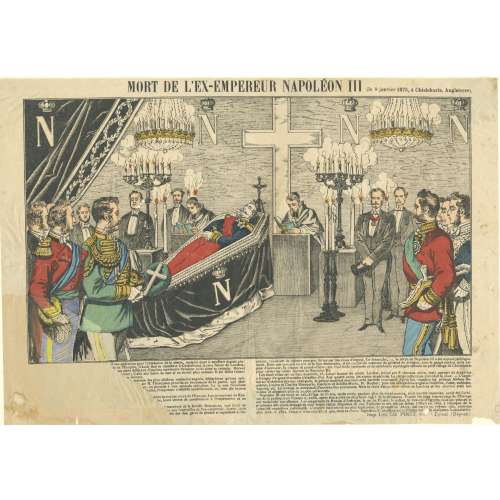 Hand-coloured woodcut on wove paper, 270 x 380 mm; attached to the sheet 303 x 442 mm with pencil ms inscription to the top left corner on the reverse: “Haye le 2-3-75”. Top: "MORT DE L'EX-EMPEREUR NAPOLÉON III (le 9 janvier 1873, à Chislehurts [sic], Angleterre)." Bottom right: "Imp. Lith. CH. PINOT, éditeur. Épinal (Dépose)". Bottom left corner of the image sheet torn and manually restored. Text partially lost, starting with « d’une opération pour l’extraction de la pierre, maladie dont’ il souffrait depuis plu-… ». See Chislehurst. Charles-François Pinot (French, 1817 – 1879) – publisher/printer.
Hand-coloured woodcut on wove paper, 270 x 380 mm; attached to the sheet 303 x 442 mm with pencil ms inscription to the top left corner on the reverse: “Haye le 2-3-75”. Top: "MORT DE L'EX-EMPEREUR NAPOLÉON III (le 9 janvier 1873, à Chislehurts [sic], Angleterre)." Bottom right: "Imp. Lith. CH. PINOT, éditeur. Épinal (Dépose)". Bottom left corner of the image sheet torn and manually restored. Text partially lost, starting with « d’une opération pour l’extraction de la pierre, maladie dont’ il souffrait depuis plu-… ». See Chislehurst. Charles-François Pinot (French, 1817 – 1879) – publisher/printer. -
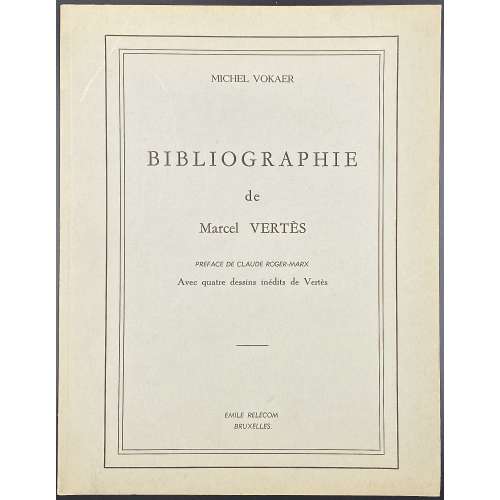 Description: Limited softcover edition in grey publisher’s wrappers 27 x 21 cm, lettered in a frame “MICHEL VOKAER | BIBLIOGRAPHIE | de | Marcel VERTÈS | PREFACE DE CLAUDE ROGER-MARX | Avec quatre dessins inédits de Vertès | — | EMILE RELECOM | BRUXELLES ||, lettered spine, pp. [1-4 h.t., t.p.] 5-34 [35, 36 blanks] [37 limitation] [38 blank] [39 colophon] [40 blank]; 40 pages total plus 4 photomechanical reproductions of Vertès’ unpublished drawings on glossy paper, extraneous to collation. Catalogue of 82 entries. Received uncut. Title-page: similar to front wrapper, plus «1967» in the bottom under BRUXELLES. Limitation: 7 copies (A-G) on Japon chamois + 2 suites of plates, 25 copies (1-25) on Hollande Van Gelder + 1 suite of plates, 450 copies (26-475) on offset Arduenna, and 40 copies not hor sale (I-XL) on different papers. The total print run is 522 copies, of which this is № 206. Ref: leslibraires.fr Contributors: Michel Vokaer (Belgian, 20th century) – author. Claude Roger-Marx (Jewish-French, 1888 – 1977) – author. Marcel Vertès [Marcell Vértes] (Jewish-Hungarian-French, 1895 – 1961) – artist. Xavier Gustave Emile Relecom (Belgian, 1900 – 1977) – publisher.
Description: Limited softcover edition in grey publisher’s wrappers 27 x 21 cm, lettered in a frame “MICHEL VOKAER | BIBLIOGRAPHIE | de | Marcel VERTÈS | PREFACE DE CLAUDE ROGER-MARX | Avec quatre dessins inédits de Vertès | — | EMILE RELECOM | BRUXELLES ||, lettered spine, pp. [1-4 h.t., t.p.] 5-34 [35, 36 blanks] [37 limitation] [38 blank] [39 colophon] [40 blank]; 40 pages total plus 4 photomechanical reproductions of Vertès’ unpublished drawings on glossy paper, extraneous to collation. Catalogue of 82 entries. Received uncut. Title-page: similar to front wrapper, plus «1967» in the bottom under BRUXELLES. Limitation: 7 copies (A-G) on Japon chamois + 2 suites of plates, 25 copies (1-25) on Hollande Van Gelder + 1 suite of plates, 450 copies (26-475) on offset Arduenna, and 40 copies not hor sale (I-XL) on different papers. The total print run is 522 copies, of which this is № 206. Ref: leslibraires.fr Contributors: Michel Vokaer (Belgian, 20th century) – author. Claude Roger-Marx (Jewish-French, 1888 – 1977) – author. Marcel Vertès [Marcell Vértes] (Jewish-Hungarian-French, 1895 – 1961) – artist. Xavier Gustave Emile Relecom (Belgian, 1900 – 1977) – publisher. -
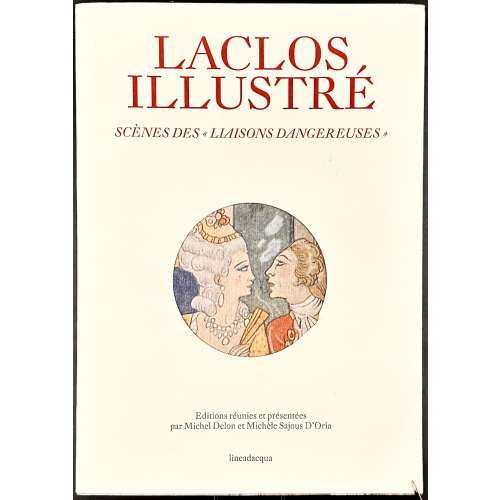 NEWSoftcover, 240 x 170 mm, creme dust jacket with red and black lettering and circular opening in the middle to front, red lettering to spine, over pictorial wrappers, pp. [1-8] 9-143 [1], ISBN 978-88-95598-25-3. 1st edition. Title-page (red and black): LACLOS | ILLUSTRE | « SCÈNES DES « LIAISONS DANGEREUSES» | Editions réunies et présentées | par Michel Delon et Michèle Sajous D'Oria | lineadacqua || Colophon: Imprimé à Venise, Italie | En février 2014 | Par Grafiche Veneziane || Publisher: Lineadacqua Edizioni; San Marco 3717/d, 30124 Venezia; www.lineadacqua.com Contributors: Michel Delon (French, b. 1947) – author Michèl Sajous D’Oria – author Contents: ILLUSTRATION ET INTERPRÉTATION – Michel Delon METTRE LES LETTRES ENSCÈNES – Michèle Sajous D'Oria LES LETTRES L'ÉCRITURE LE SECRET LA TRAHISON LE REFUS LA MARQUISE DE MERTEUIL LA PETITE MAISON LE CHEVALIER DE PRÉVAN LE RIVAL LE PIÈGE LE VICOMTE, DE VALMONT SÉDUCTIONS CÉCILE DE VOLANGES LA SURPRISE DES SENS LE VIOL LAPRÉSIDENTE DE TOURVEL L'AMOUR LA MORT FINALE Bibliographie des éditions illustrées Notices sur les illustrateurs
NEWSoftcover, 240 x 170 mm, creme dust jacket with red and black lettering and circular opening in the middle to front, red lettering to spine, over pictorial wrappers, pp. [1-8] 9-143 [1], ISBN 978-88-95598-25-3. 1st edition. Title-page (red and black): LACLOS | ILLUSTRE | « SCÈNES DES « LIAISONS DANGEREUSES» | Editions réunies et présentées | par Michel Delon et Michèle Sajous D'Oria | lineadacqua || Colophon: Imprimé à Venise, Italie | En février 2014 | Par Grafiche Veneziane || Publisher: Lineadacqua Edizioni; San Marco 3717/d, 30124 Venezia; www.lineadacqua.com Contributors: Michel Delon (French, b. 1947) – author Michèl Sajous D’Oria – author Contents: ILLUSTRATION ET INTERPRÉTATION – Michel Delon METTRE LES LETTRES ENSCÈNES – Michèle Sajous D'Oria LES LETTRES L'ÉCRITURE LE SECRET LA TRAHISON LE REFUS LA MARQUISE DE MERTEUIL LA PETITE MAISON LE CHEVALIER DE PRÉVAN LE RIVAL LE PIÈGE LE VICOMTE, DE VALMONT SÉDUCTIONS CÉCILE DE VOLANGES LA SURPRISE DES SENS LE VIOL LAPRÉSIDENTE DE TOURVEL L'AMOUR LA MORT FINALE Bibliographie des éditions illustrées Notices sur les illustrateurs


